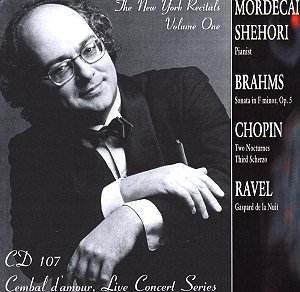Mordecai Shehori, Israeli-born, studied with the Rumanian
pianist Mindru Katz, whose legacy he has furthered by issuing performances
on Shehori’s own Cembal d’Amour label. Further studies with Beveridge
Webster and Claude Frank followed and Shehori was fortunate enough –
and talented enough – to come into Horowitz’s orbit, experiences about
which he reminisced thoughtfully and perceptively in Harold Schonberg’s
biography of Horowitz. For his recital at the Metropolitan Museum of
Art, which he gave a quarter of a century ago now, in April 1977 he
chose a demanding programme that tested technique and stylistic affinity.
The Brahms Op. 5 Sonata is a big, bold work and receives a commensurately
big, bold performance. In the opening Allegro Maestoso he is powerful
and propulsive from the initial bars and is on splendidly energetic
form. Even in the Andante he is strongly active without any sense of
rhythmic lassitude – he clearly sees this, rightly, as a youthful and
passionate work and makes no attempt to subvert that – and in the poco
piu lento section of the movement he is inwardly reflective but at a
still reasonable tempo. There are oases of romantic repose in the Finale
but Shehori’s playing is strongly forward-looking and takes a long line
in all the movements.
The trio of Chopin pieces make an intelligent grouping.
In the F minor Prelude he is excellent at contrastive playing – the
sense of romantic dreaminess and the urgency of the romantic passion
are all coalesced - and in the succeeding B major we see another side
of Shehori. Here his teasing rubati are joined by the leading voices
of the right hand and a sense of his not playing a proper legato but
preferring instead to concentrate on an intriguing use of rhythmic displacement.
His Scherzo is strong willed and passionate, with his strong, active
rhythmic sense fully engaged. In the difficult conclusion to the piece
he ties the left hand well, creating excitement in profusion and driving
to an overwhelming finish – undeniably dramatic, if perhaps rather too
much so. The recital here ends with Gaspard de la Nuit. Comparison with
so towering a Ravelian as Gieseking is instructive. Shehori isn’t as
even in Ondine as the older man; in Le Gibet Shehori prefers
insistence and intensity whereas Gieseking’s priorities are the pictorialism
of the swaying and of the church bells. Shehori’s Scarbo is certainly
malign and not to be trifled with and noticeably more athletic than
Gieseking’s.
This is a strongly characterised recital by a musician
well versed in matters of text and performance practice. My abiding
impression is of his Brahms, so full of youthful and vigorous action,
so keen to press on to the next thematic view, and so satisfying in
execution.
Jonathan Woolf
